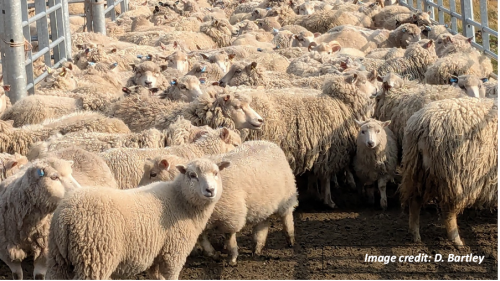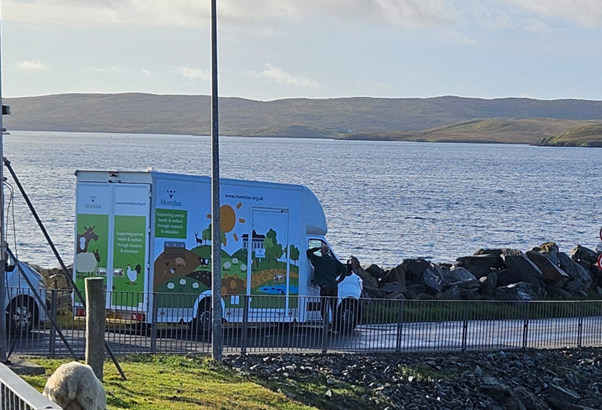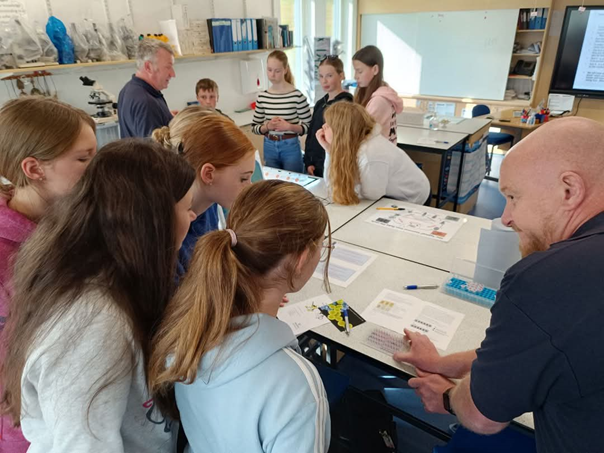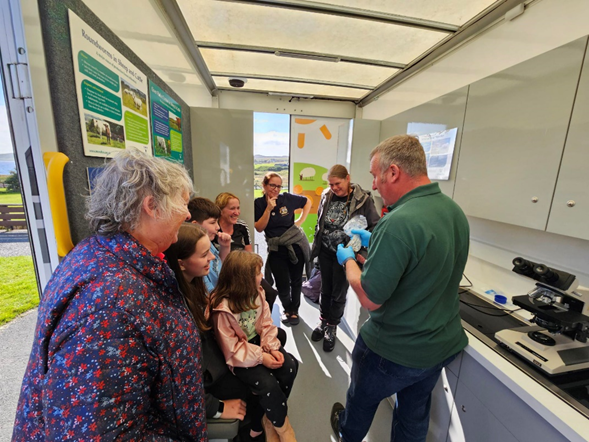The Shetland Islands are some of the most remote Islands of the UK. Therefore, opportunities for hands-on STEM science and knowledge exchange of cutting-edge research can be challenging due to distance, weather and cost. Funding from SEFARI Gateway, provided an excellent opportunity to address this last issue by sending a team of SEFARI scientists from the Moredun Research and James Hutton Institutes to the Shetland Isles for an engaging week of animal health science at the Junior High Schools and local communities.
This case study describes a packed itinerary of unique interactive workshops, diagnostic demonstrations and community engagement events, to share vital skills and knowledge about livestock disease management that engaged students, vets, vet nurses and farmers.

Stage
Directory of Expertise
Purpose
A long-standing invitation from the Shetland Animal Health Scheme’s (SAHS) Dr Hilary Burgess finally became a reality with funding from SEFARI Gateway. This provided SEFARI research staff at Moredun and James Hutton Institute to collaboratively engage with the Shetland Islanders.
The week was packed with a programme of community and educational events involving visits to the Island’s Junior High Schools in remote communities with additional evening events, including roundworm and scab control in sheep; roundworm and equine grass sickness in horses, with a faecal egg count masterclass on the Biobus.
The school visits were very well received by staff and involved 200 students, providing a wider platform for community engagement. The take home message of using diagnostic technologies for sustainable parasite control was welcomed and as you can imagine the Moredun Biobus was spotted travelling around Shetland, even before it arrived at its destination (Figure 1.).

Figure 1. Biobus awaiting to board the ferry to the island of Whalsay (Image credit - C. Hardy).
The remoter areas of the Shetland Islands were the focus of this week-long trip. All the outlying Junior High schools were included (Unst pupils travelling to Yell to participate) which also provided an excellent venue for wider community engagements on the Biobus. A visit to Anderson High School was also made for an informal career’s discussion with S5 and S6 pupils interested in careers in the biological sciences including veterinary and marine sciences.
Furthermore, additional meetings included one for equine owners focussed on updates on equine grass sickness and roundworm control, a Continued Professional Development (CPD) event for practising vets and vet nurses and a visit to the Shetland Mart to increase awareness of parasite control.
Results
This Shetland Knowledge Exchange event brought together a diverse team of people for the first time. Working closely with teams from the Shetland Islands Government and Shetland Developing the Young Workforce, the Moredun Research Institute and the James Hutton Institute put together an innovative and exciting programme of events. These included STEM activities in the Junior High Schools, workshops, CPD events and community engagement, to raise awareness of careers in research of infectious disease and the broader dissemination of skills and knowledge about livestock disease management, which resonated well with all those that attended.
Bringing scientific research to the classroom:
The hands-on STEM workshops provided an opportunity for students to run their own tests to provide results that contributed to their knowledge and understanding of how science can be used to improve the health and welfare of farm animals. These activities not only introduced students to research using laboratory equipment that they would not normally have access to in school but also gave them an insight into the importance of reporting results, which provide vets and farmers with the correct diagnosis to treat the right animals with the right treatments and also reduce building resistance to anthelmintic treatment.
Staff at the Junior High schools were excited to introduce S2-4 pupils to new skills (prior to the visits full risks assessments were undertaken and all activities used ensured pupils did not handle harmful chemicals). A role-play scenario introduced pupils to using Science, Technology, Engineering & Mathematical (STEM) skills, practical in everyday life. Many of the pupils came from families with connections to crofting, over half had experience in livestock rearing and handling. The scenario they were given was:
‘An island farmer had poorly sheep that required testing to allow the island vet to prescribe the correct treatment. Samples were taken, but the diagnostic lab were too busy to process them, so the samples were sent to the school so that the students could run the tests and provide the results to the vet. The vet was then able to communicate with the farmer advising the treatment required.’
The pupils were asked to carry out three tests. Firstly, to make practical observations, using microscopic examination to find and identify parasites (Figure 2), secondly to detect the presence of antibodies using Enzyme-Linked Immunosorbent Assay (ELISA) tests to determine whether animals were positive or negative for parasite infections (Figure 3) and finally to use extracted DNA in a detection system called gel electrophoresis, to identify resistance to treatments (Note: these tests were mock-ups of real tests to ensure pupils did not handle harmful chemicals or samples). All students had the opportunity to do all three tests and record their own results in their own personal lab books that were provided by the team.
School Practicals:
1. Parasitology
Activity: Students were provided with samples of eggs from two different fluke types, one considered non-pathogenic (rumen fluke) whilst the other (liver fluke) can cause significant health and welfare issues and production losses (including death of heavily infected animals) and asked to look for morphological/visual differences using microscopy. Being able to visually identify eggs is a quick way to differentiate between the two infections is useful, but unfortunately not all animals shed eggs all of the time, so other techniques such as the ELISA and PCR are also needed to identify infections early.
Skills: Observations, microscope detection and identification.
Key message: There are many different parasites that can infect livestock and correctly identifying the cause of symptoms is important in prescribing a targeted treatment. Faecal egg counts can help to determine the level of infection. Using a microscope for identification and counting egg numbers is an important skill to learn. Making a concise clear report is necessary to clearly convey the results of the investigation.

Figure 2: Pupils examining parasites on a lightbox (Image credit – Developing Young Workforce – Shetland Facebook pages).
2. ELISA
Activity: Students were given an explanation of an ELISA test and how it can be used to detect antibodies specific to the target pathogen (liver fluke) in blood samples from sheep. They were then provided with a demonstration of the test protocol, including guidance on how to use the pipettes to undertake the assay. Each student then performed their own ELISA using randomly assigned samples (some positive and some negative for liver fluke) along with positive and negative controls and asked to use the test cards provided to interpret their assay results. The results were recorded in their personal lab book, used to report to the vet.
Skills: Observing and following a protocol. Effective use of a micropipette, accurate loading of different samples onto the ELISA plate, interpreting the results using test cards and accurate recording and reporting of results to the vet.
Key message: The ELISA test used identifies the presence of antibodies specific for liver fluke in sheep blood. By observing a demonstration and then following a protocol, the students were asked to undertake the blood test on submitted case samples. This was then interpreted based on provided positive and negative controls and test cards. The students were also asked to reflect on the importance of using control samples and the need for replication.

Figure 3: Pupils analysing test results (Image credit – Developing Young Workforce – Shetland Facebook pages).
3. DNA Gel Electrophoresis
Activity: Changes in the DNA sequence can be used to distinguish between anthelmintic treatment resistant and susceptible liver fluke. How this test is normally done was explained to the students. Wool twisted into a double helix and cut into pieces of different lengths was used as a visual aid to illustrate the procedure of extracting DNA from parasite eggs and it was then incubated with an enzyme that acts as molecular scissors to cut the DNA into small segments. The DNA properties of electric charge and fragment size were emphasised as essential for this test to work. The theory of gel electrophoresis was described along with showing actual kits used in the lab. Students were asked to load a positive and negative control (susceptible and resistant standards) and one unknown sample into wells of an agarose gel. Due to time constraints the gels were not run to separate the DNA bands (segments) but each student was provided one of a selection of pre-run gel images that fluoresced under a UV-transilluminator. The students were able to compare the DNA pattern of their sample to the controls and decide on whether it was resistant or susceptible. They were therefore able to record whether the liver fluke was resistant or sensitive to the anthelmintic treatment in their lab books.
Skills: Control of a micropipette, loading an agar gel, detecting DNA fragments, identifying patterns, analysing and reporting skills.
Key message: DNA markers are an extremely important tool for practitioners and livestock keepers to assess a range of factors e.g. presence or absence of a pathogen, and likelihood of treatment success. This task allowed the students to consider the likely outcome of a treatment administration and what alternatives may be available if the treatment were to fail.
Equine Grass Sickness (EGS) and Roundworm Control for Equine Keepers
Shetland has a thriving horse riding and Shetland pony breeding community. An evening meeting was arranged by the British Horse Society Shetland, to discuss the current research programmes in EGS and how horse owners and vets can play a part in providing samples and information from EGS cases. EGS is a deveastation disease of equids, where 80% of cases sadly die, and where the casual agents are not known. Shetland has a history of this disease and those attending, including breeders, horse owners and vets, were highly engaged.
Following this meeting, further discussions have taken place to facilitate provision of samples from EGS cases to the national EGS Biobank, held at Moredun. The second part of the meeting involved an update on equine roundworm control, using best practice advice from the Controlling ANTiparasitic resistance in Equines Responsibly (CANTER) group on using wormers responsibly to slow down the development of resistance. Lengthy discussions on the practical application of this advice for Shetland pony herds followed.
Continuing Professional Development (CPD) for Vets and Vet Nurses
This training event involved two parts; firstly a theory section looking at the optimal use and interpretation of parasite monitoring tools and diagnostics. The event centred around the control of parasites namely roundworms and sheep scab on an Island situation. Part of the session focussed on raising awareness of disease and the importance of strict biosecurity for bought-in animals to ensure that the unique position that Shetland has, as the only part of the UK, which is free of sheep scab is maintained. The session also covered the use of faecal egg counts in sheep and explored the potential pitfalls at different stages and how to troubleshoot the most common issues. The session culminated in a hands-on session, in the Biobus, looking at faecal egg counting as a monitoring and testing tool to assess for roundworm parasite eggs.
Wider Community Engagement
Activities held after each school visit allowed local people including farmers and crofters to visit the Biobus and talk with SEFARI researchers. Farmers and crofters took up the invitation to bring fresh faecal samples from their sheep and watch a demonstration of practical faecal egg counting whilst hearing about the advantages of treating animals only after receiving a diagnosis (Figure 4). Meetings and discussions focussed on the correct use of diagnostics in order to provide the right treatments at the right time and also reduce anthelminthic resistance.
SAHS have an effective animal health scheme operating for imported animals, as can be seen in the Shetland animal disease control virtual tour, however it was good to hear from remotely located livestock producers (Figure 4) about the importance of this level of disease control. Stakeholders were quick to praise the existing scheme and voiced how they felt their livestock were ‘safe’ from disease, and that the vets ‘work hard to protect the flocks and herds from disease’. Several farmers reported that they buy island-bred livestock, especially tups, that are ‘trusted’ in terms of a low level of disease. They believed they receive a premium price for livestock and were confident in sending stock to mainland markets to achieve competitive prices.

Figure 4: Community members on Shetland visiting the Biobus (Image credit: C. Hardy).
We would like to thank everyone who made this trip a reality and a success. It was great to be able to arrive in these remote communities and immediately feel welcomed with big smiles and open arms.
Some, but not all, include:
- Nina Høgmo and Emma Chittick from The Shetland Developing the Young Workforce team for all their hard work acting as organisers and co-ordinators of the schools’ visits and making sure we had a warm welcome. They acted as facilitators of the visits, introducing pupils that had interests in careers in bioscience to the scientists, these included pupils out with the year groups we were primarily working with.
- Hilary Burgess, Lucia Malcolmson and Roberto Getto all from Shetland Islands government. For co-ordinating the visit and travelling with us as we went around Shetland.
There were also a number of staff at the schools that dropped into the events to learn more about what was going on. - The dinner ladies for providing excellent healthy and quality lunches (from local produce) during our brief and often late lunch breaks, thank you for your patience!
- All the Shetland people who were all welcoming and happy to give up their time.
- Moredun and Hutton support staff for helping with planning and organising resources
Finally, we would also like to express our gratitude to SEFARI Gateway for providing the funding.
Benefits
This event enabled a number of highly skilled people from very diverse backgrounds to work together as a team, many for the first time.
We have created an experience that was both interesting and exciting, whilst also academically worthwhile with the intention that the staff at the Institutes will endeavour to continue to deliver these types of opportunities. The feedback from the schools and staff and pupils was very positive:
“Having the Moredun Institute delivering workshops across our schools was a great experience for us as well as for the pupils and teachers.”
The staff found the experience useful both for themselves and the pupils:
“I would love for them to come up again if possible, thanks so much for their time and effort as it was so appreciated.”
The collaboration and support continues….
We have already followed up the visits to the schools and staff sending additional resources and offering future support. Further STEM courses are planned using island teachers with support from Moredun staff. The link to the Shetland interactive virtual tour, showing the animal health scheme process, was shared to schools as requested as an additional resource for pupils to engage with.
Faecal samples delivered to the Biobus during the visit, to check post quarantine treatment to ensure it was working, were followed up with a second sampling and testing. Conversations with the Island vets and vet nurses have continued with advice and resources being shared.
The evening meeting with equine owners highlighted interest in health issues which will lead to further joint working between the Shetland equine community, Shetland Vets and Moredun will include Shetland in future equine grass sickness research.
Livestock stakeholders that engaged with the researchers at the Shetland Mart were knowledgeable about parasite control, and keen to discuss enhanced measures to improve their livestock production rates. When asked about engaging with other island communities to share animal disease measures, they felt it would be advantageous at the farm-level for them and important at the industry-level for the island as a whole – opening more avenues to explore.
Vets were asked about their reflections on joining a pan-island network to share working practices and experiences on keeping livestock safe from disease and introducing control measures on an island wide control scheme. Shetland vets felt they would welcome an opportunity to engage on several levels, at the livestock producer level to help discussions on the concept of good practice to protect the island flocks, as well as on a vet practice level for peer-to-peer exchanges and general support. They felt the vet practice level would be beneficial to share work experiences to help other vet practices introduce wide acting measures and experiences on managing the workload of additional testing.
An opportunity for further Island crofter interaction with an upcoming EU thematic network project is being planned as is the instigation of a pan-island network to share experiences of livestock disease control in an island setting, focussing on the benefits from their unique geographical settings, rather than being at a disadvantage of being remote from the mainland producers. The islanders from Shetland, Orkney, Lewis and Harris have expressed an interest in such an initiative. RESAS, the EPIC CoE and the SRP are supporting a combined pan-island collaboration meeting in Inverness in 2025.
With SEFARI Gateway funding and cooperation both from the Institutes and commitment from the staff these events can continue to be delivered. This is especially important for remote rural communities that are often omitted but who really appreciate the effort that goes into creating these experiences.
Project Partners
Moredun Research Institute
James Hutton Institute
Shetland Developing the Young Workforce
Shetland Animal Health Scheme
SEFARI Gateway